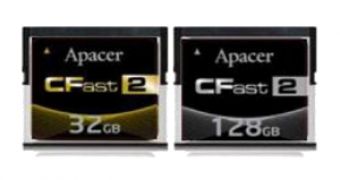The CompactFlash standard started out as one of the fastest and most capacious types of memory cards, steamrolling past SD and its variations and establishing its role in various applications. Now, Apacer has launched its most advanced CF cards.
Said memory cards comply with the CFast 2.0 specification, the latest technology from the CompactFlash Association.
Thus, the Apacer CFast 2.0 cards manage to be twice as fast as their predecessors, reaching read speeds of 310 MB/s and write speeds of 240 MB/s.
This performance is actually necessary here, since CompactFlash cards have a higher maximum capacity than SDHC, microSDHC, etc.
Which is to say, in addition to chips of 4 GB to 32 GB, there are 16 GB to 128 GB capacities as well, all inside packages of 42.8 mm x 36.4 mm x 3.6 mm.
In all cases, the cards connect to whatever embedded system, military, gaming or network communication device they are installed in via 7+15 pin connectors.
Apacer allows customers to choose whether they want the cards to be made from SLC (single-level cell) or MLC (multi-level cell) NAND Flash chips.
The former are the ones that cover the 4 GB ¬– 32 GB capacity range we have mentioned, while the latter provide the 16 GB to 128 GB options.
“Apacer CFast 2.0 memory card is upgraded to double performance and speed, in order to meet the needs of harsh environment of industrial application and corporate cost-effectiveness,” says Jeff Lin, embedded application business unit director of Apacer.
Apacer's new CFast 2.0 memory cards have 40-bit ECC (Error Correcting Code) support, S.M.A.R.T. (Self-Monitoring, Analysis and Reporting Technology) and Wear Leveling Technology, plus the company's unique security instruction (CoreSecurity Technology), CoreProtector. Both hardware and software settings can be used to ensure data safety.
Finally, for DEVSLP (Device Sleep) power mode is supported, enabling the cards to switch into a low power state on standby mode, saving power and, by extension, cost of ownership.

 14 DAY TRIAL //
14 DAY TRIAL //